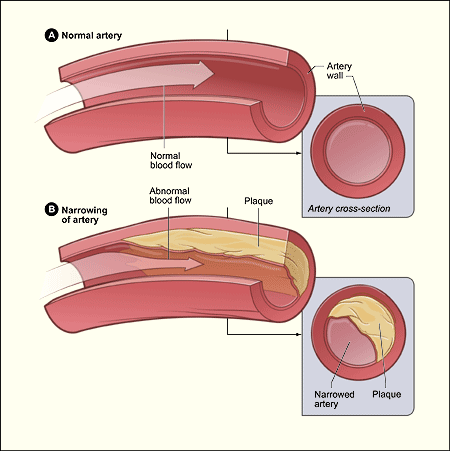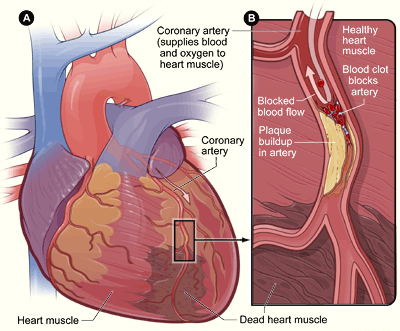Coronary Artery Disease
Coronary artery disease (CAD) is a condition in which plaque (plak) builds up inside the coronary arteries. These arteries supply your heart muscle with oxygen-rich blood.
Other Names for Coronary Artery Disease
- Atherosclerosis
- Coronary heart disease
- Hardening of the arteries
- Heart disease
- Ischemic (is-KE-mik) heart disease
- Narrowing of the arteries
Plaque is made up of fat, cholesterol (ko-LES-ter-ol), calcium, and other substances found in the blood. When plaque builds up in the arteries, the condition is called atherosclerosis (ATH-er-o-skler-O-sis).
Atherosclerosis

Figure A shows a normal artery with normal blood flow. Figure B shows an artery with plaque buildup.
Plaque narrows the arteries and reduces blood flow to your heart muscle. It also makes it more likely that blood clots will form in your arteries. Blood clots can partially or completely block blood flow.
Overview
When your coronary arteries are narrowed or blocked, oxygen-rich blood can't reach your heart muscle. This can cause angina (an-JI-nuh or AN-juh-nuh) or a heart attack.
Angina is chest pain or discomfort that occurs when not enough oxygen-rich blood is flowing to an area of your heart muscle. Angina may feel like pressure or squeezing in your chest. The pain also may occur in your shoulders, arms, neck, jaw, or back.
A heart attack occurs when blood flow to an area of your heart muscle is completely blocked. This prevents oxygen-rich blood from reaching that area of heart muscle and causes it to die. Without quick treatment, a heart attack can lead to serious problems and even death.
Over time, CAD can weaken the heart muscle and lead to heart failure and arrhythmias (ah-RITH-me-ahs). Heart failure is a condition in which your heart can't pump enough blood throughout your body. Arrhythmias are problems with the speed or rhythm of your heartbeat.
Outlook
CAD is the most common type of heart disease. It's the leading cause of death in the United States for both men and women. Lifestyle changes, medicines, and/or medical procedures can effectively prevent or treat CAD in most people.
What Causes Coronary Artery Disease?
Research suggests that coronary artery disease (CAD) starts when certain factors damage the inner layers of the coronary arteries. These factors include:
- Smoking
- High amounts of certain fats and cholesterol in the blood
- High blood pressure
- High amounts of sugar in the blood due to insulin resistance or diabetes
When damage occurs, your body starts a healing process. Excess fatty tissues release compounds that promote this process. This healing causes plaque to build up where the arteries are damaged.
The buildup of plaque in the coronary arteries may start in childhood. Over time, plaque can narrow or completely block some of your coronary arteries. This reduces the flow of oxygen-rich blood to your heart muscle.
Plaque also can crack, which causes blood cells called platelets (PLATE-lets) to clump together and form blood clots at the site of the cracks. This narrows the arteries more and worsens angina or causes a heart attack.
Who Is At Risk for Coronary Artery Disease?
Coronary artery disease (CAD) is the leading cause of death in the United States for both men and women. Each year, more than half a million Americans die from CAD.
Certain traits, conditions, or habits may raise your chance of developing CAD. These conditions are known as risk factors.
You can control most risk factors and help prevent or delay CAD. Other risk factors can't be controlled.
Major Risk Factors
Many factors raise the risk of developing CAD. The more risk factors you have, the greater chance you have of developing CAD.
- Unhealthy blood cholesterol levels. This includes high LDL cholesterol (sometimes called bad cholesterol) and low HDL cholesterol (sometimes called good cholesterol).
- High blood pressure. Blood pressure is considered high if it stays at or above 140/90 mmHg over a period of time.
- Smoking. This can damage and tighten blood vessels, raise cholesterol levels, and raise blood pressure. Smoking also doesn't allow enough oxygen to reach the body's tissues.
- Insulin resistance. This condition occurs when the body can't use its own insulin properly. Insulin is a hormone that helps move blood sugar into cells where it's used.
- Diabetes. This is a disease in which the body's blood sugar level is high because the body doesn't make enough insulin or doesn't use its insulin properly.
- Overweight or obesity. Overweight is having extra body weight from muscle, bone, fat, and/or water. Obesity is having a high amount of extra body fat.
- Metabolic syndrome. Metabolic syndrome is the name for a group of risk factors linked to overweight and obesity that raise your chance for heart disease and other health problems, such as diabetes and stroke.
- Lack of physical activity. Lack of activity can worsen other risk factors for CAD.
- Age. As you get older, your risk for CAD increases. Genetic or lifestyle factors cause plaque to build in your arteries as you age. By the time you're middle-aged or older, enough plaque has built up to cause signs or symptoms.
- In men, the risk for CAD increases after age 45.
- In women, the risk for CAD risk increases after age 55.
- Family history of early heart disease. Your risk increases if your father or a brother was diagnosed with CAD before 55 years of age, or if your mother or a sister was diagnosed with CAD before 65 years of age.
Although age and a family history of early heart disease are risk factors, it doesn't mean that you will develop CAD if you have one or both.
Making lifestyle changes and/or taking medicines to treat other risk factors can often lessen genetic influences and prevent CAD from developing, even in older adults.
Emerging Risk Factors
Scientists continue to study other possible risk factors for CAD.
High levels of a protein called C-reactive protein (CRP) in the blood may raise the risk for CAD and heart attack. High levels of CRP are proof of inflammation in the body. Inflammation is the body's response to injury or infection. Damage to the arteries' inner walls seems to trigger inflammation and help plaque grow.
Research is under way to find out whether reducing inflammation and lowering CRP levels also can reduce the risk of developing CAD and having a heart attack.
High levels of fats called triglycerides in the blood also may raise the risk of CAD, particularly in women.
Other Factors That Affect Coronary Artery Disease
Other factors also may contribute to CAD. These include:
- Sleep apnea. Sleep apnea is a disorder in which your breathing stops or gets very shallow while you're sleeping. Untreated sleep apnea can raise your chances of having high blood pressure, diabetes, and even a heart attack or stroke.
- Stress. Research shows that the most commonly reported "trigger" for a heart attack is an emotionally upsetting event-particularly one involving anger.
- Alcohol. Heavy drinking can damage the heart muscle and worsen other risk factors for heart disease. Men should have no more than two drinks containing alcohol a day. Women should have no more than one drink containing alcohol a day.
What Are the Signs and Symptoms of Coronary Artery Disease?
A common symptom of coronary artery disease (CAD) is angina. Angina is chest pain or discomfort that occurs when your heart muscle doesn't get enough oxygen-rich blood.
Angina may feel like pressure or a squeezing pain in your chest. You also may feel it in your shoulders, arms, neck, jaw, or back. This pain tends to get worse with activity and go away when you rest. Emotional stress also can trigger the pain.
Another common symptom of CAD is shortness of breath. This symptom happens if CAD causes heart failure. When you have heart failure, your heart can't pump enough blood throughout your body. Fluid builds up in your lungs, making it hard to breathe.
The severity of these symptoms varies. The symptoms may get more severe as the buildup of plaque continues to narrow the coronary arteries.
Signs and Symptoms of Heart Problems Linked to Coronary Artery Disease
Some people who have CAD have no signs or symptoms. This is called silent CAD. It may not be diagnosed until a person show signs and symptoms of a heart attack, heart failure, or an arrhythmia (an irregular heartbeat).
Heart Attack
A heart attack happens when an area of plaque in a coronary artery breaks apart, causing a blood clot to form.
The blood clot cuts off most or all blood to the part of the heart muscle that's fed by that artery. Cells in the heart muscle die because they don't receive enough oxygen-rich blood. This can cause lasting damage to your heart. For more information, see the animation in "What Causes a Heart Attack?"
Heart With Muscle Damage and a Blocked Artery

Figure A is an overview of a heart and coronary artery showing damage (dead heart muscle) caused by a heart attack. Figure B is a cross-section of the coronary artery with plaque buildup and a blood clot.
The most common symptom of heart attack is chest pain or discomfort. Most heart attacks involve discomfort in the center of the chest that lasts for more than a few minutes or goes away and comes back. The discomfort can feel like pressure, squeezing, fullness, or pain. It can be mild or severe. Heart attack pain can sometimes feel like indigestion or heartburn.
Heart attacks also can cause upper body discomfort in one or both arms, the back, neck, jaw, or stomach. Shortness of breath or fatigue (tiredness) often may occur with or before chest discomfort. Other symptoms of heart attack are nausea (feeling sick to your stomach), vomiting, lightheadedness or fainting, and breaking out in a cold sweat.
Heart Failure
Heart failure is a condition in which your heart can't pump enough blood to your body. Heart failure doesn't mean that your heart has stopped or is about to stop working. It means that your heart can't fill with enough blood or pump with enough force, or both.
This causes you to have shortness of breath and fatigue that tends to increase with activity. Heart failure also can cause swelling in your feet, ankles, legs, and abdomen.
Arrhythmia
An arrhythmia is a problem with the speed or rhythm of the heartbeat. When you have an arrhythmia, you may notice that your heart is skipping beats or beating too fast. Some people describe arrhythmias as a fluttering feeling in their chests. These feelings are called palpitations.
Some arrhythmias can cause your heart to suddenly stop beating. This condition is called sudden cardiac arrest (SCA). SCA can make you faint and it can cause death if it's not treated right away.
For more information, see the animations in "Types of Arrhythmia."
How Is Coronary Artery Disease Diagnosed?
Your doctor will diagnose coronary artery disease (CAD) based on:
- Your medical and family histories
- Your risk factors
- The results of a physical exam and diagnostic tests and procedures
Diagnostic Tests and Procedures
No single test can diagnose CAD. If your doctor thinks you have CAD, he or she will probably do one or more of the following tests.
EKG (Electrocardiogram)
An EKG is a simple test that detects and records the electrical activity of your heart. An EKG shows how fast your heart is beating and whether it has a regular rhythm. It also shows the strength and timing of electrical signals as they pass through each part of your heart.
Certain electrical patterns that the EKG detects can suggest whether CAD is likely. An EKG also can show signs of a previous or current heart attack.
Stress Testing
During stress testing, you exercise to make your heart work hard and beat fast while heart tests are performed. If you can't exercise, you're given medicine to speed up your heart rate.
When your heart is beating fast and working hard, it needs more blood and oxygen. Arteries narrowed by plaque can't supply enough oxygen-rich blood to meet your heart's needs. A stress test can show possible signs of CAD, such as:
- Abnormal changes in your heart rate or blood pressure
- Symptoms such as shortness of breath or chest pain
- Abnormal changes in your heart rhythm or your heart's electrical activity
During the stress test, if you can't exercise for as long as what's considered normal for someone your age, it may be a sign that not enough blood is flowing to your heart. But other factors besides CAD can prevent you from exercising long enough (for example, lung diseases, anemia, or poor general fitness).
Some stress tests use a radioactive dye, sound waves, positron emission tomography (PET), or cardiac magnetic resonance imaging (MRI) to take pictures of your heart when it's working hard and when it's at rest.
These imaging stress tests can show how well blood is flowing in the different parts of your heart. They also can show how well your heart pumps blood when it beats.
Echocardiography
This test uses sound waves to create a moving picture of your heart. Echocardiography provides information about the size and shape of your heart and how well your heart chambers and valves are working.
The test also can identify areas of poor blood flow to the heart, areas of heart muscle that aren't contracting normally, and previous injury to the heart muscle caused by poor blood flow.
Chest X Ray
A chest x ray takes a picture of the organs and structures inside the chest, including your heart, lungs, and blood vessels.
A chest x ray can reveal signs of heart failure, as well as lung disorders and other causes of symptoms that aren't due to CAD.
Blood Tests
Blood tests check the levels of certain fats, cholesterol, sugar, and proteins in your blood. Abnormal levels may show that you have risk factors for CAD.
Electron-Beam Computed Tomography
Your doctor may recommend electron-beam computed tomography (EBCT). This test finds and measures calcium deposits (called calcifications) in and around the coronary arteries. The more calcium detected, the more likely you are to have CAD.
EBCT isn't used routinely to diagnose CAD, because its accuracy isn't yet known.
Coronary Angiography and Cardiac Catheterization
Your doctor may ask you to have coronary angiography (an-jee-OG-ra-fee) if other tests or factors show that you're likely to have CAD. This test uses dye and special x rays to show the insides of your coronary arteries.
To get the dye into your coronary arteries, your doctor will use a procedure called cardiac catheterization (KATH-e-ter-i-ZA-shun). A long, thin, flexible tube called a catheter is put into a blood vessel in your arm, groin (upper thigh), or neck. The tube is then threaded into your coronary arteries, and the dye is released into your bloodstream. Special x rays are taken while the dye is flowing through your coronary arteries.
Cardiac catheterization is usually done in a hospital. You're awake during the procedure. It usually causes little to no pain, although you may feel some soreness in the blood vessel where your doctor put the catheter.
How Is Coronary Artery Disease Treated?
Treatment for coronary artery disease (CAD) may include lifestyle changes, medicines, and medical procedures. The goals of treatments are to:
- Relieve symptoms
- Reduce risk factors in an effort to slow, stop, or reverse the buildup of plaque
- Lower the risk of blood clots forming, which can cause a heart attack
- Widen or bypass clogged arteries
- Prevent complications of CAD
Lifestyle Changes
Making lifestyle changes can often help prevent or treat CAD. For some people, these changes may be the only treatment needed:
- Follow a heart healthy eating plan to prevent or reduce high blood pressure and high blood cholesterol and to maintain a healthy weight
- Increase your physical activity. Check with your doctor first to find out how much and what kinds of activity are safe for you.
- Lose weight, if you're overweight or obese.
- Quit smoking, if you smoke. Avoid exposure to secondhand smoke.
- Learn to cope with and reduce stress.
Follow a Heart Healthy Eating Plan
For a heart healthy eating plan, go to the National Heart, Lung, and Blood Institute's (NHLBI's) Aim for a Healthy Weight Web site. This site provides practical tips on healthy eating, physical activity, and controlling your weight.
Therapeutic Lifestyle Changes (TLC). Your doctor may recommend TLC if you have high cholesterol. TLC is a three-part program that includes a healthy diet, physical activity, and weight management.
With the TLC diet, less than 7 percent of your daily calories should come from saturated fat. This kind of fat is mainly found in meat and poultry, including dairy products. No more than 25 to 35 percent of your daily calories should come from all fats, including saturated, trans, monounsaturated, and polyunsaturated fats.
You also should have less than 200 mg a day of cholesterol. The amounts of cholesterol and the different kinds of fat in prepared foods can be found on the Nutrition Facts label.
Foods high in soluble fiber also are part of a healthy eating plan. They help block the digestive track from absorbing cholesterol. These foods include:
- Whole grain cereals such as oatmeal and oat bran
- Fruits such as apples, bananas, oranges, pears, and prunes
- Legumes such as kidney beans, lentils, chick peas, black-eyed peas, and lima beans
A diet high in fruits and vegetables can increase important cholesterol-lowering compounds in your diet. These compounds, called plant stanols or sterols, work like soluble fiber.
Fish are an important part of a heart healthy diet. They're a good source of omega-3 fatty acids, which may help protect the heart from blood clots and inflammation and reduce the risk for heart attack. Try to have about two fish meals every week. Fish high in omega-3 fats are salmon, tuna (canned or fresh), and mackerel.
You also should try to limit the amount of sodium (salt) that you eat. This means choosing low-sodium and low-salt foods and "no added salt" foods and seasonings at the table or when cooking. The Nutrition Facts label on food packaging shows the amount of sodium in the item.
Try to limit alcoholic drinks. Too much alcohol will raise your blood pressure and triglyceride level. (Triglycerides are a type of fat found in the blood.) Alcohol also adds extra calories, which will cause weight gain. Men should have no more than two alcoholic drinks a day. Women should have no more than one alcoholic drink a day.
See the NHLBI's "Your Guide to Lowering Your Cholesterol With TLC" for more information.
Dietary Approaches to Stop Hypertension (DASH) eating plan. Your doctor may recommend the DASH eating plan if you have high blood pressure. The DASH eating plan focuses on fruits, vegetables, whole grains, and other foods that are heart healthy and lower in salt/sodium.
This eating plan is low in fat and cholesterol. It also focuses on fat-free or low-fat milk and dairy products, fish, poultry, and nuts. The DASH eating plan is reduced in red meat (including lean red meat), sweets, added sugars, and sugar-containing beverages. It's rich in nutrients, protein, and fiber.
The DASH eating plan is a good heart healthy eating plan, even for those who don't have high blood pressure. See the NHLBI's "Your Guide to Lowering Your Blood Pressure With DASH" for more information.
Increase Physical Activity
Regular physical activity can lower many CAD risk factors, including LDL ("bad") cholesterol, high blood pressure, and excess weight. Physical activity also can lower your risk for diabetes and raise your levels of HDL cholesterol (the "good" cholesterol that helps prevent CAD).
Check with your doctor about how much and what kinds of physical activity are safe for you. Unless your doctor tells you otherwise, try to get at least 30 minutes of moderate-intensity activity on most or all days of the week. You can do the activity all at once or break it up into shorter periods of at least 10 minutes each.
Moderate-intensity activities include brisk walking, dancing, bowling, bicycling, gardening, and housecleaning.
More intense activities, such as jogging, swimming, and various sports, also may be appropriate for shorter periods. See the NHLBI's "Your Guide to Physical Activity and Your Heart" for more information.
Maintain a Healthy Weight
Maintaining a healthy weight can decrease risk factors for CAD. If you're overweight, aim to reduce your weight by 7 to 10 percent during your first year of treatment. This amount of weight loss can lower your risk for CAD and other health problems.
After the first year, you may have to continue to lose weight so you can lower your body mass index (BMI) to less than 25.
BMI measures your weight in relation to your height and gives an estimate of your total body fat. A BMI between 25 and 29 is considered overweight. A BMI of 30 or more is considered obese. A BMI of less than 25 is the goal for preventing and treating CAD.
You can calculate your BMI using the NHLBI's online calculator, or your health care provider can calculate your BMI.
For more information on losing weight and maintaining your weight, see the Diseases and Conditions Index Overweight and Obesity article.
Quit Smoking
If you smoke or use tobacco, quit. Smoking can damage and tighten blood vessels and raise your risk for CAD. Talk to your doctor about programs and products that can help you quit. The U.S. Department of Health and Human Services also has information on how to quit smoking.
You also should avoid exposure to secondhand smoke.
Reduce Stress
Research shows that the most commonly reported "trigger" for a heart attack is an emotionally upsetting event-particularly one involving anger. Also, some of the ways people cope with stress, such as drinking, smoking, or overeating, aren't heart healthy.
Physical activity can help relieve stress and reduce other CAD risk factors. Many people also find that meditation or relaxation therapy helps them reduce stress.
Medicines
You may need medicines to treat CAD if lifestyle changes aren't enough. Medicines can:
- Decrease the workload on your heart and relieve CAD symptoms
- Decrease your chance of having a heart attack or dying suddenly
- Lower your cholesterol and blood pressure
- Prevent blood clots
- Prevent or delay the need for a special procedure (for example, angioplasty or coronary artery bypass grafting (CABG))
Medicines used to treat CAD include anticoagulants (AN-te-ko-AG-u-lants), aspirin and other antiplatelet (an-ty-PLAYT-lit) medicines, ACE inhibitors, beta blockers, calcium channel blockers, nitroglycerin, glycoprotein IIb-IIIa, statins, and fish oil and other supplements high in omega-3 fatty acids.
Medical Procedures
You may need a medical procedure to treat CAD. Both angioplasty and CABG are used as treatments.
Angioplasty opens blocked or narrowed coronary arteries. During angioplasty, a thin tube with a balloon or other device on the end is threaded through a blood vessel to the narrowed or blocked coronary artery. Once in place, the balloon is inflated to push the plaque outward against the wall of the artery. This widens the artery and restores the flow of blood.
Angioplasty can improve blood flow to your heart, relieve chest pain, and possibly prevent a heart attack. Sometimes a small mesh tube called a stent is placed in the artery to keep it open after the procedure.
In CABG, arteries or veins from other areas in your body are used to bypass (that is, go around) your narrowed coronary arteries. CABG can improve blood flow to your heart, relieve chest pain, and possibly prevent a heart attack.
You and your doctor can discuss which treatment is right for you.
Cardiac Rehabilitation
Your doctor may prescribe cardiac rehabilitation (rehab) for angina or after CABG, angioplasty, or a heart attack. Cardiac rehab, when combined with medicine and surgical treatments, can help you recover faster, feel better, and develop a healthier lifestyle. Almost everyone with CAD can benefit from cardiac rehab.
The cardiac rehab team may include doctors, nurses, exercise specialists, physical and occupational therapists, dietitians, and psychologists or other behavioral therapists.
Rehab has two parts:
- Exercise training. This part helps you learn how to exercise safely, strengthen your muscles, and improve your stamina. Your exercise plan will be based on your individual abilities, needs, and interests.
- Education, counseling, and training. This part of rehab helps you understand your heart condition and find ways to reduce your risk for future heart problems. The cardiac rehab team will help you learn how to cope with the stress of adjusting to a new lifestyle and with your fears about the future.
For more information on cardiac rehab, see the Diseases and Conditions Index Cardiac Rehabilitation article.
How Can Coronary Artery Disease Be Prevented or Delayed?
Taking action to control your risk factors can help prevent or delay coronary artery disease (CAD). Your chance of developing CAD goes up with the number of risk factors you have.
Making lifestyle changes and taking prescribed medicines are important steps. See "How Is Coronary Artery Disease Treated?" for information on heart healthy eating plans, physical activity, maintaining a healthy weight, and medicines.
Know your family history of health problems related to CAD. If you or someone in your family has CAD, be sure to tell your doctor. Also, let your doctor know if you smoke.
Living With Coronary Artery Disease
Coronary artery disease (CAD) can cause serious complications. However, if you follow your doctor's advice and change your habits, you can prevent or reduce the chances of:
- Dying suddenly from heart problems
- Having a heart attack and permanently damaging your heart muscle
- Damaging your heart because of reduced oxygen supply
- Having arrhythmias (irregular heartbeats)
Ongoing Health Care Needs
Doing physical activity regularly, taking prescribed medicines, following a heart healthy eating plan, and watching your weight can help control CAD. (See "How Is Coronary Artery Disease Treated?" for more information).
See your doctor regularly to keep track of your blood pressure and blood cholesterol and blood sugar levels. A cholesterol blood test will show your levels of LDL ("bad") cholesterol, HDL ("good") cholesterol, and triglycerides. A fasting blood glucose test will check your blood sugar level and show if you're at risk for or have diabetes. These tests will show whether you need more treatments for your CAD.
Talk to your doctor about how often you should schedule office visits or blood tests. Between those visits, call your doctor if you develop any new symptoms or if your symptoms worsen.
CAD raises your risk for heart attack. Learn the symptoms of heart attack and arrhythmia. Call 9-1-1 if you have any of these symptoms for more than 5 minutes:
- Chest discomfort or pain-uncomfortable pressure, squeezing, fullness, or pain in the center of the chest that can be mild or strong. This discomfort or pain lasts more than a few minutes or goes away and comes back.
- Upper body discomfort in one or both arms, the back, neck, jaw, or stomach.
- Shortness of breath, which may occur with or before chest discomfort.
It's important to know the difference between angina and a heart attack. During a heart attack, the pain is usually more severe than angina, and it doesn't go away when you rest or take medicine. If you don't know whether your chest pain is angina or a heart attack, call 9-1-1.
Let the people you see regularly know you're at risk for a heart attack. They can seek emergency care if you suddenly faint, collapse, or develop other severe symptoms.
You may feel depressed or anxious if you've been diagnosed with CAD and/or had a heart attack. You may worry about heart problems or making lifestyle changes that are necessary for your health. Your doctor may recommend medicine, professional counseling, or relaxation therapy if you have depression or anxiety.
Physical activity can improve mental well-being, but you should talk to your doctor before starting any fitness activities. It's important to treat any anxiety or depression that develops because it raises your risk of having a heart attack.
Key Points
- Coronary artery disease (CAD), also called coronary heart disease, is a condition in which plaque builds up inside the coronary arteries. These arteries supply your heart muscle with oxygen-rich blood.
- Plaque narrows the coronary arteries and reduces blood flow to your heart muscle. It also makes it more likely that blood clots will form in your arteries. Blood clots can partially or completely block blood flow.
- CAD can lead to angina, heart attack, heart failure, and arrhythmias (irregular heartbeats).
- CAD is the most common type of heart disease. It's the leading cause of death in the United States for both men and women.
- Research suggests that CAD starts when certain factors damage the inner layers of the coronary arteries. When damage occurs, your body starts a healing process. This healing causes plaque to build up where the artery is damaged. Over time, the plaque may crack and causes blood clots to form in the arteries. This can worsen angina or cause a heart attack.
- Many factors raise the risk of developing CAD. Major risk factors include unhealthy blood cholesterol levels, high blood pressure, smoking, insulin resistance, diabetes, overweight or obesity, metabolic syndrome, lack of physical activity, age, and a family history of early heart disease.
- Common symptoms of CAD are angina and shortness of breath. However, some people have no signs or symptoms. This is called silent CAD. It may not be diagnosed until a person shows signs and symptoms of a heart attack, heart failure, or an arrhythmia.
- Your doctor will diagnose CAD based on your medical and family histories, your risk factors, and the results of diagnostic tests.
- Treatment for CAD may include lifestyle changes, medicines, and medical procedures. Lifestyle changes include following a heart healthy eating plan, increasing physical activity, maintaining a healthy weight, quitting smoking, and reducing stress.
- Taking action to control your risk factors can help prevent or delay CAD. You can take action by making lifestyle changes and/or taking medicines as prescribed by your doctor.
- If you've been diagnosed with CAD, you can control the disease with lifestyle changes and medicines. See your doctor regularly, and call him or her if you develop any new symptoms or your symptoms become more severe.









